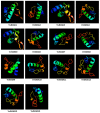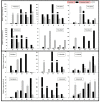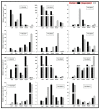Genome-Wide Characterization and Expression Profiling of GASA Genes during Different Stages of Seed Development in Grapevine (Vitis vinifera L.) Predict Their Involvement in Seed Development
- PMID: 32041336
- PMCID: PMC7036793
- DOI: 10.3390/ijms21031088
Genome-Wide Characterization and Expression Profiling of GASA Genes during Different Stages of Seed Development in Grapevine (Vitis vinifera L.) Predict Their Involvement in Seed Development
Abstract
Members of the plant-specific GASA (gibberellic acid-stimulated Arabidopsis) gene family have multiple potential roles in plant growth and development, particularly in flower induction and seed development. However, limited information is available about the functions of these genes in fruit plants, particularly in grapes. We identified 14 GASA genes in grapevine (Vitis vinifera L.) and performed comprehensive bioinformatics and expression analyses. In the bioinformatics analysis, the locations of genes on chromosomes, physiochemical properties of proteins, protein structure, and subcellular positions were described. We evaluated GASA proteins in terms of domain structure, exon-intron distribution, motif arrangements, promoter analysis, phylogenetic, and evolutionary history. According to the results, the GASA domain is conserved in all proteins and the proteins are divided into three well-conserved subgroups. Synteny analysis proposed that segmental and tandem duplication have played a role in the expansion of the GASA gene family in grapes, and duplicated gene pairs have negative selection pressure. Most of the proteins were predicted to be in the extracellular region, chloroplasts, and the vacuole. In silico promoter analysis suggested that the GASA genes may influence different hormone signaling pathways and stress-related mechanisms. Additionally, we performed a comparison of the expression between seedless (Thompson seedless) and seeded (Red globe) cultivars in different plant parts, including the ovule during different stages of development. Furthermore, some genes were differentially expressed in different tissues, signifying their role in grapevine growth and development. Several genes (VvGASA2 and 7) showed different expression levels in later phases of seed development in Red globe and Thompson seedless, suggesting their involvement in seed development. Our study presents the first genome-wide identification and expression profiling of grapevine GASA genes and provides the basis for functional characterization of GASA genes in grapes. We surmise that this information may provide new potential resources for the molecular breeding of grapes.
Keywords: Cis-elements; GASR; VvGAST; bioinformatics; grapevine; ovule abortion.
Conflict of interest statement
The authors declare no conflict of interest.
Figures







References
MeSH terms
Substances
Grants and funding
LinkOut - more resources
Full Text Sources

